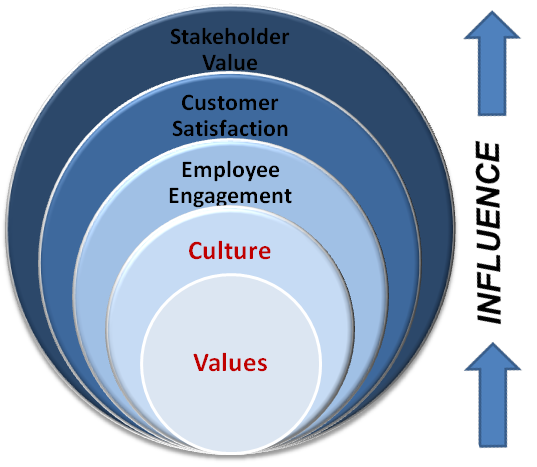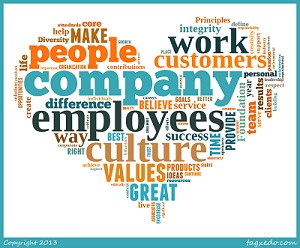In 2012, The Corporate Executive Board’s annual list of top 10 risks CEOs and Executives are most concerned with ranked “Corporate Culture” as #4. In the past two years, I have been involved with two significant culture shifts; one is with a 5,000 person hospital and the other is a 900-person Crown Corporation. My role, as an external consultant, is to work collaboratively with them to shift their cultures to be more strategically positioned and better aligned with their corporate vision and espoused values. A great place to start when focusing on culture shift, is to identify the organization’s current and desired culture to determine employees’ perceptions which indicate alignment (or not) between the two. What are the elements that comprise an organization’s culture?
 Alignment is important within your culture
A gap between what an organization espouses as its culture (transparent, team oriented, innovative) and what is tacit (the unseen what’s really going on) can be at the heart of cultural dissonance. For instance, do we say we value innovation but have a low tolerance for risk? Or that we value trustworthiness but do not take immediate action around workplace bullying? Addressing these incongruences by surfacing the tacit norms, beliefs and assumptions is the foundation of lasting change. If you are curious about what can you do to positively influence your organization’s culture and minimize risks to employee and customer engagement, consider the following strategies:
Alignment is important within your culture
A gap between what an organization espouses as its culture (transparent, team oriented, innovative) and what is tacit (the unseen what’s really going on) can be at the heart of cultural dissonance. For instance, do we say we value innovation but have a low tolerance for risk? Or that we value trustworthiness but do not take immediate action around workplace bullying? Addressing these incongruences by surfacing the tacit norms, beliefs and assumptions is the foundation of lasting change. If you are curious about what can you do to positively influence your organization’s culture and minimize risks to employee and customer engagement, consider the following strategies:
Organizational Culture Defined
”… taken-for-granted values, underlying assumptions, expectations and definitions that characterize organizations and their members. It also includes unobservable elements such as implicit assumptions, conscious contracts & norms and observable elements (i.e., artifacts & explicit behaviours).”In other words, culture is what we see and don’t visibly see (but it’s there). When we are new to a culture, it is easier to identify its particular elements than when we are entrenched in it. If you want to know about a company’s culture, ask a recent hire. They easily notice the behaviours, norms and assumptions while trying to make sense of the organization and its people in order to ‘fit in’.Cameron & Quinn, Diagnosing and Changing Organizational Culture.
Values are Important to your Culture
Values are the cornerstone of culture. Values are defined as our beliefs and the behaviours predicated on these beliefs. Beliefs influence our behaviours and our behaviours influence the culture. According to Tony Hsieh, CEO of Zappos, a company that prides itself on its culture, endorses the benefits of core values:“Your personal core values define who you are, and a company’s core values ultimately define the company’s character and brand. For individuals, character is destiny. For organizations, culture is destiny.” Tony Hsieh, Zappos CEOThe following model (Mark Fulton), depicts the relationship between values, culture and the experience of our employees and our customers.
 Alignment is important within your culture
A gap between what an organization espouses as its culture (transparent, team oriented, innovative) and what is tacit (the unseen what’s really going on) can be at the heart of cultural dissonance. For instance, do we say we value innovation but have a low tolerance for risk? Or that we value trustworthiness but do not take immediate action around workplace bullying? Addressing these incongruences by surfacing the tacit norms, beliefs and assumptions is the foundation of lasting change. If you are curious about what can you do to positively influence your organization’s culture and minimize risks to employee and customer engagement, consider the following strategies:
Alignment is important within your culture
A gap between what an organization espouses as its culture (transparent, team oriented, innovative) and what is tacit (the unseen what’s really going on) can be at the heart of cultural dissonance. For instance, do we say we value innovation but have a low tolerance for risk? Or that we value trustworthiness but do not take immediate action around workplace bullying? Addressing these incongruences by surfacing the tacit norms, beliefs and assumptions is the foundation of lasting change. If you are curious about what can you do to positively influence your organization’s culture and minimize risks to employee and customer engagement, consider the following strategies:
- Identify your employees’ personal and organizational values to determine alignment
- Encourage engagement
- Step up as informal leaders
- Be empowered
- Take calculated risks
- Be accountable
- Contribute to the organization’s strategic goals
- Think more as an ‘owner’ who can influence positive change
- Harness strengths
- Have a clear and strong vision
- Leaders walking-the-talk
- Integrate culture shift into your existing initiatives (vs a stand-alone initiative)
- Allow for emergence, feedback and adaptation
- Be committed to the time it takes
- Informal and formal structures and procedures
- Human resource processes (e.g. performance feedback, compensation, recruitment, payroll, retention, succession, onboarding, etc.)
- KPIs and other performance indicators
- Sales and incentive structures
- Environmental and sustainability principles and guidelines
- Customer satisfaction metrics
- Leadership development programs and metrics
- Decision-making and escalation protocols
- Financial mechanisms
- IT infrastructures
- Communication mechanisms and messaging
- Ensure shared ownership/sponsorship
- Have fun…really
- Why Culture Matters: Lessons from an Executive Panel Discussion http://knowledge.senndelaney.com/docs/articles/pdf/HRroundtable2012.pdf?goback=%2Egmp_2091237%2Eamf_2091237_3386069
- “Engagement & Culture: Engaging Talent in Turbulent Times” by Hewitt http://www.aon.com/attachments/thought-leadership/hewitt_pov_engagement_and_culture.pdf
- John P. Kotter and James L. Heskett, Corporate Culture and Performance (New York: The Free Press) 1992
- Cracking the Culture Code: The Key to High Performing Organizations, Libby Sartain & Brent Daily (RoundPegg Culture Management Software)
- Richard Axelrod, Terms of Engagement: Changing the Way We Change Organizations”, (California: Berrett-Koehler Publishers Inc). 2000



4 Responses
Oh God this is my life right now. So timely! Thanks for this article.
Glad you liked it! Anytime..stay tuned – next month is on Team!
Great perspectives, I like this musing and the leadership teamwork one as well.
Thanks Jeff. Next one will be on Conflict – stay tuned 🙂